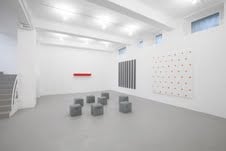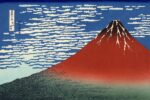Genesi del Fare

La mostra ripercorre l’evoluzione di una direttrice dell’arte contemporanea che ha privilegiato la formazione di una nuova grammatica espressiva, a partire dalla ricerca della sintesi tra colore, atto pittorico, materia e forma.
Comunicato stampa
La galleria A arte Studio Invernizzi inaugura martedì 11 dicembre 2012 alle ore 18.30 la mostra "Genesi del fare" che ripercorre l’evoluzione di una direttrice dell’arte contemporanea che ha privilegiato la formazione di una nuova grammatica espressiva, a partire dalla ricerca della sintesi tra colore, atto pittorico, materia e forma.
Punto di partenza del percorso espositivo è l’opera "Spazio totale: progressioni ritmiche simultanee in variazione vibratile" realizzata nel 1953 da Mario Nigro, artista che dalla fine degli anni Quaranta guarda alle origini di un’esperienza non oggettiva come mezzo per interrogarsi sull’essenza dell’esistenza umana.
Al piano superiore, opere di Enrico Castellani, Gianni Colombo, Dadamaino, François Morellet e Grazia Varisco si propongono come ipotesi di attraversamento e superamento dell’immagine, come soglia che si apre alla conoscenza del tutto oltre il confine della bidimensionalità, per ritrovare forza comunicativa con ancor nuova energia. Questa ricerca, che affonda le proprie radici nel clima culturale degli anni Cinquanta in Europa ed a Milano, non si esaurisce nel tempo e trova nuove chiavi di lettura e di espressione nelle opere di Rodolfo Aricò e Carlo Ciussi, realizzate tra la fine degli anni Sessanta e l’inizio degli anni Settanta ed esposte nella seconda sala dello stesso piano, pervase da una continua tensione progettuale che indaga forme e colori in una sintesi che tende all’universale. Allo stesso modo le sculture di Nicola Carrino, strettamente legate all’idea di costruzione e decostruzione, e di Mauro Staccioli, caratterizzate dall’essenzialità geometrica delle strutture, si esplicitano come l’esito di una riflessione sull’idea stessa di scultura, riletta in una prospettiva che guarda al divenire perdendo la propria entità autoreferenziale e divenendo un elemento specificatamente pensato per lo spazio di destinazione, per rispondere a un’esigenza di compenetrazione e individualità.
Nel terzo ambiente del piano superiore David Tremlett crea, con il tratto del pastello su carta, delicati equilibri di verticalità e orizzontalità tra forme geometriche elementari mentre Lesley Foxcroft indaga l’espressività artistica di materiali legati all’uso quotidiano, come carta, cartoncino e MDF.
Al piano inferiore della galleria, i lavori di artisti europei e americani quali Alan Charlton, Sol Lewitt, John McCracken, Ulrich Rückriem, Niele Toroni riflettono sulla possibilità di un gesto essenziale e sintetico che attraversi e percorra lo spazio espositivo. L’utilizzo di un elemento reiterativo di analisi, come le impronte di pennello di Niele Toroni, il colore grigio delle tele di Alan Charlton o il sezionare la pietra dolomitica in forme primarie di Ulrich Rückriem, diviene la cifra stilistica di una ricerca che si differenzia, per il legame che intercorre tra l’opera e la volontà di creare dei singoli artisti, dalle strutture primarie della Minimal Art americana di Sol Lewitt e John McCracken.
In un’altra sezione dello stesso piano si trovano i risultati più recenti di questo percorso. Le opere degli anni Ottanta caratterizzate dalla riflessione sullo spazio di Bruno Querci, che trasporta sulla tela un delicato equilibrio di campiture bianche e nere, e di Nelio Sonego, che trascrive sul fondo bianco le vibrazioni energetiche attraverso le cromie accese di colori acrilici, e dagli "éclairages" di Michel Verjux, che indagano gli ambienti con le loro proiezioni, portano negli anni Novanta a una ulteriore riflessione che si esprime nel gesto della foratura compiuto da Riccardo De Marchi su superfici in plexiglas e nella considerazione dell’architettura come parte fondante dell’opera di Francesco Candeloro. Queste opere esprimono, infatti, altrettante possibilità di lettura e sviluppo di un percorso artistico continuamente "in fieri".
In occasione della mostra verrà pubblicato un catalogo bilingue con la riproduzione delle opere esposte, un saggio introduttivo di Daria Ghiradini, una poesia di Carlo Invernizzi e un apparato biografico.
ARTISTI ESPOSTI: Rodolfo Aricò, Francesco Candeloro, Nicola Carrino, Enrico Castellani, Alan Charlton, Carlo Ciussi, Gianni Colombo, Dadamaino, Riccardo De Marchi, Lesley Foxcroft, Sol LeWitt, John McCracken, François Morellet, Mario Nigro, Bruno Querci, Ulrich Rückriem, Nelio Sonego, Mauro Staccioli, Niele Toroni, David Tremlett, Grazia Varisco, Michel Verjux.
Ufficio Stampa
Alessandra Valsecchi Cell. 340 3405184 [email protected]
The A arte Studio Invernizzi gallery will be opening on Tuesday 11 December 2012 at 6.30 p.m. the exhibition "Genesis of Doing" which explores the evolution of a direction of contemporary which favoured the formation of a new expressive grammar starting out from the synthesis between colour, pictorial act, matter and form.
The work that opens the exhibition is entitled "Spazio totale: progressioni ritmiche simultanee in variazione vibratile" ("Total Space: Simultaneous Rhythmic Progressions in Vibratory Variation"), created by Mario Nigro in 1953, an artist who from the close of the 1940s looked to the origins of a non-objective experience as the means for questioning himself about the essence of human existence.
On the upper floor the works by Enrico Castellani, Gianni Colombo, Dadamaino, François Morellet and Grazia Varisco propose themselves as hypotheses of the passing through and superseding of the image, as the threshold that opens itself to the knowledge of everything beyond the 'borderline' of bidimensionality in order to once again find communicative force with still newer energy. This research that sank its roots in the cultural climate of the 1950s in Europe and Milan, did not exhaust its stimuli but found new keys for reading and expression in the works by Rodolfo Aricò and Carlo Ciussi, produced between the end of the 1960s and the beginning of the 1970s, exhibited in the gallery in the second room of the upper floor, imbued with a continuous tension of the project which investigates forms and colours in a synthesis that tends towards the universal. In the same way the sculptures by Nicola Carrino, closely tied to the idea of construction and deconconstruction, and Mauro Staccioli, characterised by the geometrical essentiality of the structures, are plainly stated as the result of a reflection treating the same idea of sculpture, reread within a perspective that looks to the future, losing its self-referential entity and becoming an element specifically ideated for the place where it will be put, in this way responding to a need for interpenetration and individuality.
The third room on the upper floor houses works by David Tremlett who, with the line of pastel on paper, creates delicate equilibriums of verticality and horizontality amidst elementary geometrical forms, whereas Lesley Foxcroft explores the artistic expressiveness of materials forming part of daily use such as paper, card and M.D.F. (Medium Density Fiberboard).
On the Gallery's lower floor the works by European and American artists like Alan Charlton, Sol Lewitt, John McCracken, Ulrich Rückriem and Niele Toroni reflect upon the possibility of an essential and synthetic gesture which passes through the exhibition space. The use of a reiterative element of analysis, such as the brush marks on the part of Niele Toroni, the grey canvases of Alan Charlton or the selection of Dolomitic stone in primary forms by Ulrich Rückriem, becomes the stylistic particularity of a research work that due to the tie which exists between the work and the desire to create by the individual artist is differentiated from the primary structures of the American Minimal Art of Sol Lewitt and John McCracken.
In another section of the same floor we find the most recent results of this exhibition course. The works of the 1980s characterised by the reflection on space by Bruno Querci, who transfers a delicate equilibrium of white and black grounds onto the canvas, by Nelio Sonego who on the white background transcribes energetic vibrations by way of the lit acrylic colours, and by the "éclairages" by Michel Verjux which investigate environments with their projections. These works lead us to the 1990s and to a further reflection expressed in the 'holing' gesture carried out by Riccardo De Marchi on the surfaces of plexiglass, as also with the use of architecture as the fundamental part of the work by Francesco Candeloro. In fact, these works express an equal number of possibilities for the reading and development of an artistic investigation that is continuously "in fieri".
A bilingual catalogue will be published on the occasion of the exhibition with the reproductions of the works, an introductory essay by Daria Ghirardini, a poem by Carlo Invernizzi and biographical notes.
ARTISTS EXHIBITED: Rodolfo Aricò, Francesco Candeloro, Nicola Carrino, Enrico Castellani, Alan Charlton, Carlo Ciussi, Gianni Colombo, Dadamaino, Riccardo De Marchi, Lesley Foxcroft, Sol LeWitt, John McCracken, François Morellet, Mario Nigro, Bruno Querci, Ulrich Rückriem, Nelio Sonego, Mauro Staccioli, Niele Toroni, David Tremlett, Grazia Varisco, Michel Verjux.



